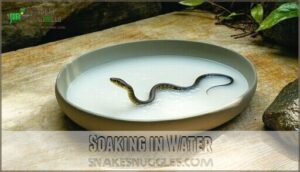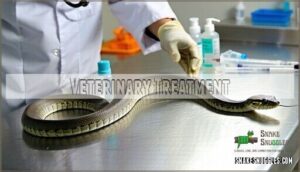This site is supported by our readers. We may earn a commission, at no cost to you, if you purchase through links.

Desert rattlesnakes can last up to 200 days thanks to specialized scales that channel rainwater and ultra-efficient kidneys.
You’ll spot dehydration through sunken eyes, wrinkled scales, and skin that stays tented when pinched.
Behavioral red flags include excessive hiding, reduced appetite, and desperate soaking attempts.
Temperature and humidity play key roles—high heat accelerates water loss while low humidity creates additional stress.
Ball pythons need 50-60% humidity to stay healthy.
Understanding these survival limits and warning signs becomes essential when you’re caring for different snake species in captivity, considering factors like water loss.
Table Of Contents
- Key Takeaways
- Snake Water Survival Rates
- Signs of Dehydration in Snakes
- Causes of Dehydration in Ball Pythons
- Risks of Dehydration in Snakes
- Rehydrating a Dehydrated Ball Python
- Preventing Dehydration in Ball Pythons
- General Reptile Hydration Needs
- Emergency Care for Dehydrated Snakes
- Frequently Asked Questions (FAQs)
- How long can a snake go without water?
- Are snakes dehydrated?
- What are the symptoms of dehydration in snakes?
- How long can a rattlesnake go without water?
- How long can a ball python go without water?
- How do you rehydrate a snake?
- How long can a snake go without drinking water?
- How to tell if a snake is dehydrated?
- How do you save a dehydrated snake?
- How does snake size affect water requirements?
- Conclusion
Key Takeaways
- You’ll see clear physical warning signs – sunken eyes, wrinkled skin that stays tented when pinched, and lethargy indicate that your snake needs immediate water access
- Most snakes survive 10-14 days without water, but desert species, like rattlesnakes, can last up to 200 days thanks to specialized water-collecting scales and efficient kidneys
- Environmental factors dramatically affect survival time – high temperatures and low humidity accelerate dehydration, while ball pythons specifically need 50-60% humidity to stay healthy
- Quick action prevents serious complications – rehydrate through lukewarm soaking, increase enclosure humidity, and seek veterinary care if symptoms persist or worsen
Snake Water Survival Rates
You’ll be surprised to learn that snakes can survive much longer without water than you might expect, with some species lasting weeks or even months.
The survival time depends heavily on the snake’s species, environment, and specialized adaptations that help them conserve every drop of moisture, which is a key factor in their ability to survive for weeks or even months.
Desert-Adapted Snakes
In desert environments, certain snake species showcase remarkable desert survival adaptations.
Desert snakes turn water scarcity into a survival masterpiece through ingenious biological engineering
Rattlesnakes can survive up to 200 days without water through specialized water conservation mechanisms.
Their scale adaptations include microchannels that funnel rainwater directly to their mouths during rare precipitation events.
Desert species have evolved efficient reptile physiology that minimizes water loss through reduced metabolic rates and behavioral modifications.
Understanding rattlesnake water collection is essential for appreciating their survival abilities.
Key adaptations of desert dwelling snakes include:
- Specialized scales with microscopic channels for water collection
- Behavioral coiling and body flattening to maximize rainwater capture surface area
- Physiological tolerance allowing survival through extreme water deprivation periods
Water-Adapted Snakes
Unlike their desert cousins, water-adapted snakes face different hydration challenges.
These aquatic species have mastered snake hydration through remarkable adaptations. Sea snakes drink saltwater and excrete excess salt, while freshwater species absorb moisture through their skin during swimming.
This aquatic adaptation reduces their need for frequent drinking compared to terrestrial snakes. Water-adapted snakes can survive longer periods without direct water access because they’ve evolved efficient water conservation methods.
Their specialized scales and enhanced kidney function help maintain proper hydration levels. However, snake dehydration can still occur if these species are removed from their aquatic environments for extended periods, which highlights the importance of aquatic environments and proper hydration levels for their survival, showcasing their remarkable adaptations and ability to excrete excess salt.
Factors Affecting Water Survival
Several factors determine how long you’ll find a snake surviving without water.
Species Variance plays a huge role – Desert Survival experts like rattlesnakes can last 200 days thanks to specialized Water Adaptation and slower Metabolic Rates.
Environmental Impact matters too; high temperatures and low humidity accelerate snake dehydration.
Age, size, and activity level also influence water deprivation tolerance, making snake hydration needs highly individual.
Signs of Dehydration in Snakes
Recognizing dehydration in your snake early can mean the difference between a quick fix and a serious health crisis.
You’ll notice several telltale signs that indicate your snake needs immediate attention to restore proper hydration levels.
Physical Symptoms
Your snake’s body language tells the story of dehydration through clear skin elasticity changes.
When pinched, healthy skin snaps back quickly—dehydrated skin stays tented.
Watch for eye sunkenness, wrinkled scales around the neck, and a dry mouth.
Lethargy often accompanies these dehydration symptoms, making your dehydrated snake appear dull and lifeless.
These signs of snake dehydration require immediate attention.
Behavioral Changes
Beyond physical symptoms, your snake’s behavior tells a story about its hydration status.
Watch for these key dehydration symptoms and signs of snake dehydration:
- Hiding Behavior – Extended periods in shelters, avoiding normal activity levels
- Soaking Frequency – Increased attempts to submerge in water dishes or humid areas
- Feeding Habits – Refusing meals or showing decreased appetite as stress signals emerge
These behavioral changes indicate your snake’s body is conserving water and energy during dehydration.
Environmental Factors
Environmental factors play a major role in snake dehydration symptoms.
Temperature Control issues, poor Humidity Levels, and limited Water Sources create stress for your snake.
Geographic Variance affects Climate Adaptation – desert species handle heat better than humid environment dwellers.
Monitor your snake’s water intake and watch for water deprivation signs when conditions change unexpectedly.
Causes of Dehydration in Ball Pythons
Several factors can cause your ball python to become dehydrated, with environmental conditions being the primary culprits.
High temperatures, low humidity levels, inadequate water sources, and internal parasites all contribute to fluid loss in these sensitive reptiles, leading to dehydration.
High Temperature
High temperatures push your ball python’s body beyond its thermal limits, triggering heat stress and accelerated water loss.
When enclosure temps exceed 89°F, your snake loses moisture through increased respiration and skin evaporation. This creates a dangerous cycle where temperature regulation becomes harder as snake dehydration worsens, especially compared to desert survival adaptations.
Understanding the risks of dehydration symptoms is essential for maintaining a healthy environment.
Here are key heat-related dehydration triggers:
- Overheated basking spots above 95°F cause rapid water deprivation through excessive panting
- Poor ventilation traps hot air, creating heat pockets that accelerate moisture loss
- Inadequate temperature gradients prevent your snake from finding cooler zones to regulate body heat
- Heat lamp placement too close to hides forces constant exposure without relief options
Incorrect Humidity
Wrong humidity levels throw off your ball python’s water absorption and scale health.
When humidity drops below 50%, dehydration risks spike as your snake loses moisture through its skin.
Low humidity causes skin issues like stuck sheds and brittle scales.
Monitor humidity control closely—aim for 50-60% to prevent snake dehydration and maintain proper water deprivation prevention in your pet’s environment.
Insufficient Water Intake
Your snake’s water bowl size matters more than you think.
Small, shallow bowls discourage drinking and create water deprivation issues.
Ball pythons need bowls large enough for soaking, which supports proper snake hydration and fluid balance.
Dirty water also prevents adequate water absorption, and proper snake water needs mean preventing dehydration effects before they start.
Change water weekly and monitor for signs of snake dehydration like wrinkled skin or sunken eyes.
Parasites
Beyond water issues, Internal Parasites pose another serious threat to your ball python’s hydration.
Snake Mites and Intestinal Worms drain nutrients, leading to snake dehydration symptoms. These tiny freeloaders create a perfect storm for dehydrated snake conditions through constant stress on your pet’s system.
- Snake Mites appear as tiny moving dots, causing excessive scratching and soaking behavior
- Intestinal Worms trigger weight loss, lethargy, and irregular bowel movements in infected snakes
- External Infestations increase water loss through damaged skin and constant irritation from scratching
- Parasite Control requires immediate veterinary treatment to prevent severe signs of snake dehydration
Risks of Dehydration in Snakes
When your snake doesn’t get enough water, serious health problems can develop that threaten its life.
Dehydration damages essential organs, disrupts digestion, and causes toxic waste to build up in your pet’s body, which can be a result of dehydration.
Organ Damage
Dehydration wreaks havoc on your snake’s essential organs, creating cascading health problems that can prove fatal.
When water levels drop dangerously low, your pet’s internal systems start breaking down systematically.
- Kidney Failure develops as toxins concentrate, overwhelming the filtration system and causing permanent nephrotoxic damage
- Liver Damage occurs when hepatic blood flow decreases, leading to cellular death and impaired detoxification processes
- Cardiac Problems emerge from reduced plasma volume, causing dangerous arrhythmias and potential circulatory collapse
Skin Health
Your snake’s skin bears the brunt when dehydration strikes.
Watch for telltale signs of snake dehydration: wrinkled, loose skin that lacks skin elasticity.
When you pinch it, healthy skin snaps back instantly—dehydrated snake skin stays tented.
Scale health deteriorates, becoming dry and brittle.
Shedding issues multiply as dry skin can’t properly separate, creating stuck shed that invites infection and parasites.
Digestive Issues
When dehydration strikes, your snake’s digestive system suffers substantially.
Water deprivation disrupts normal digestion problems and compromises gut health throughout the digestive tract.
- Food absorption becomes severely impaired without adequate water intake
- Bowel issues develop as dehydrated intestines struggle to process meals properly
- Constipation occurs when insufficient moisture hardens waste materials
- Nutrient deficiencies emerge from poor digestive function and malabsorption
- Appetite loss happens as the body prioritizes conserving energy over eating
Metabolic Waste Buildup
When water deprivation strikes, your snake’s kidneys can’t flush toxic compounds effectively, creating dangerous buildup.
Kidney function deteriorates rapidly during snake dehydration, slowing essential detox processes.
Metabolic rates drop as waste removal systems fail, turning your pet’s body into a toxic environment.
Without proper snake hydration needs met, this signs of snake dehydration becomes life-threatening quickly.
Rehydrating a Dehydrated Ball Python
When you notice signs of dehydration in your ball python, you’ll need to act quickly to restore their water balance.
Quick action saves your ball python’s life when dehydration strikes
The good news is that most dehydrated ball pythons respond well to proper rehydration techniques when caught early.
Soaking in Water
Gentle soaking techniques offer the most effective water absorption method for snake dehydration.
Fill a shallow container with lukewarm water—around 80-85°F—ensuring it reaches your snake’s belly but not higher.
These hydration methods work best during 10-15 minute sessions, allowing natural snake bathing behavior.
Monitor water temperature closely, as overheating stresses dehydrated reptiles.
Proper soaking techniques address water deprivation safely while supporting recovery.
Effective ball python care requires understanding ball python soak methods to prevent dehydration.
Misting The Enclosure
Beyond simply providing a water bowl, misting creates a humidity microclimate that encourages natural snake hydration behavior.
Regular misting sessions increase Enclosure Temperature regulation while boosting Humidity Control to ideal levels.
Your dehydrated ball python will absorb moisture through its skin during these gentle spray treatments.
Maintain proper Mist Frequency using quality Water Quality sources, as effective Spray Systems support thorough snake dehydration recovery alongside improved water intake patterns.
Proper fogger mister systems can also aid in maintaining ideal humidity levels for ball pythons.
Soaking Food
Food-moisture enhancement serves as a practical hydration technique for dehydrated ball pythons.
You can increase your snake’s water intake by soaking prey items in lukewarm water before feeding. This feeding method boosts water absorption while maintaining normal eating patterns.
- Soak frozen-thawed rodents for 10-15 minutes – transforms dry prey into moisture-rich meals
- Monitor feeding response closely – confirms your snake accepts the modified texture
- Use clean, dechlorinated water – prevents harmful chemicals from affecting nutrient uptake
- Track hydration improvements – watch for better skin elasticity and increased activity levels
This approach works especially well for snakes showing signs of snake dehydration, as it addresses snake water needs through natural feeding methods rather than forced drinking.
Electrolyte-Rich Water
While soaking food helps, electrolyte-rich water provides faster snake hydration recovery. Electrolyte balance supports cellular rehydration and prevents metabolic acidosis during water therapy.
You can create mineral supplements using pediatric solutions or homemade mixtures. These restore sodium and potassium levels more effectively than plain water for dehydration prevention.
Using an electrolyte water supplement can be beneficial in maintaining the proper balance. The following solutions can be used to create electrolyte-rich water:
| Solution Type | Mixing Ratio |
|---|---|
| Unflavored Pedialyte | 1:1 with water |
| Homemade saline | 1 tsp salt per quart |
| Commercial reptile electrolytes | Follow package directions |
| Coconut water (unsweetened) | 1:2 with water |
| Veterinary oral fluids | Professional guidance required |
These solutions help in achieving the right electrolyte balance and support cellular rehydration, which is crucial for overall health and metabolic acidosis prevention. By using these methods, you can ensure a faster and more effective recovery from dehydration.
Veterinary Treatment
When home remedies fall short, professional Veterinary Care becomes necessary.
Veterinarians can perform Dehydration Diagnosis through blood tests and physical examination.
Emergency Treatment may include fluid therapy – intravenous, subcutaneous, or intracoelomic injections to restore hydration quickly.
Advanced Rehydration Methods like Snake Hospitalization in humidity-controlled environments help severe cases.
Don’t hesitate seeking professional help when Signs of Snake Dehydration persist despite your efforts.
Preventing Dehydration in Ball Pythons
Preventing dehydration in your ball python requires consistent attention to their environment and water supply.
You’ll need to maintain proper humidity levels, provide fresh water daily, and monitor temperature to keep your snake healthy and hydrated.
Providing Fresh Water
Proper bowl maintenance keeps your ball python healthy and hydrated. Fresh water supply prevents bacterial growth that can harm your snake.
Change water every 2-3 days, or immediately if contaminated. Choose ceramic or plastic bowls over metal ones, which can affect water temperature.
Using the right water bowls is essential for maintaining a healthy environment.
- Size matters: Select bowls wide enough for soaking but shallow enough to prevent drowning
- Water quality counts: Use dechlorinated or bottled water to avoid skin irritation
- Temperature control: Keep water at room temperature, never hot or ice-cold
- Strategic placement: Position away from direct heat sources to prevent rapid evaporation
Monitoring Humidity
While maintaining proper Humidity Control prevents snake dehydration symptoms, you’ll need consistent Environmental Monitoring to achieve ideal Water Balance.
Check Moisture Levels daily using a reliable hygrometer for effective Snake Hydration.
| Humidity Level | Action |
|---|---|
| 50-60% | Ideal for ball pythons, no action needed |
| Below 50% | Increase water intake sources, mist enclosure |
| Above 70% | Improve ventilation, reduce misting frequency |
| Fluctuating | Calibrate hygrometer, adjust humidity gradually |
Regular monitoring prevents water deprivation and dehydration.
Optimal Temperature
Temperature control plays a pivotal role in preventing snake dehydration symptoms and maintaining proper hydration levels. Ball pythons need specific thermal gradients to regulate their water needs effectively.
When ambient temperature drops too low or rises too high, your snake’s body struggles to process water efficiently.
Here’s how to maintain ideal ranges for your ball python:
- Set daytime temperatures between 78-80°F (26-27°C) on the cool side and 88-92°F (31-33°C) on the warm side
- Use reliable heat sources like under-tank heaters or ceramic heat emitters for consistent warmth
- Create proper thermal gradients by placing heat sources at one end of the enclosure
- Monitor temperatures daily with digital thermometers to prevent water deprivation from temperature stress
Consistent temperature control supports your snake’s natural hydration techniques and reduces dehydration risks substantially.
Suitable Substrate
Your substrate choice directly impacts moisture levels and preventing dehydration in ball pythons.
Choose materials that naturally control humidity while supporting your snake’s health.
| Substrate Materials | Water Absorption | Humidity Control |
|---|---|---|
| Cypress mulch | High | Excellent |
| Coconut fiber | Moderate | Good |
| Paper towels | Low | Poor |
| Aspen shavings | Very low | Minimal |
Opt for cypress mulch or coconut fiber – these soil types retain moisture without causing respiratory problems.
Avoid sand or cedar shavings that can’t maintain proper moisture levels, leaving your python vulnerable to water deprivation and snake dehydration symptoms.
General Reptile Hydration Needs
Understanding reptile hydration needs is essential because different species have vastly different water requirements and drinking behaviors.
While desert snakes like rattlesnakes can survive months without water, tropical species need constant access to moisture through drinking, soaking, and proper humidity levels.
Species-Specific Needs
Different snake species have vastly different water requirements based on their natural habitats.
Desert adaptation allows rattlesnakes to survive 200 days without water, while tropical species like ball pythons need access within 12 days.
Species variance is dramatic – king cobras can last seven months, but aquatic snakes require constant moisture.
Understanding your snake’s environmental needs prevents dehydration and guarantees proper snake hydration for peak health.
Drinking Methods
Snakes employ various drinking techniques that showcase nature’s ingenuity.
Understanding these methods helps you prevent snake dehydration more effectively.
- Scale funneling – Desert rattlesnakes channel rainwater through specialized scale grooves directly to their mouths
- Mouth absorption – Snakes lap water with their tongues, creating suction for efficient water intake
- Skin hydration – Aquatic species absorb moisture through their skin while soaking or swimming
- Droplet collection – Many snakes drink from dew and raindrops collected on vegetation surfaces
- Prey moisture extraction – Wild snakes obtain significant hydration from their prey’s body fluids during feeding
Humidity Requirements
Beyond drinking, humidity levels play a pivotal role in snake hydration needs and overall skin health.
You’ll want to maintain species-specific humidity ranges – desert snakes need 30-50% while tropical species require 60-80%.
Proper environmental control prevents water deprivation through skin absorption and moisture management.
Monitor levels with reliable gauges, adjusting through misting or substrate changes to prevent dehydration symptoms.
Emergency Care for Dehydrated Snakes
When you spot dehydration signs in your snake, quick action can prevent serious health complications.
You’ll need to assess the severity and provide immediate first aid while preparing for potential veterinary care.
Recognizing Dehydration
Spotting a dehydrated snake isn’t rocket science, but you need to know what you’re looking for.
Check these Snake Dehydration Symptoms immediately:
- Dry skin that feels like parchment and won’t snap back when pinched
- Sunken eyes that appear dull and receded into the skull
- Sluggish movements and reduced Snake Behavior activity levels
- Poor shedding with skin peeling off in irregular patches instead of one piece
These Dehydration Signs signal your pet needs immediate Water Intake attention.
First Aid Measures
After spotting dehydration symptoms, quick action helps your snake recover.
These emergency care methods provide immediate rehydration tips and dehydration aid.
Water therapy through soaking offers the most effective snake revival technique.
Place your dehydrated snake in lukewarm water for gentle rehydration.
Emergency care requires careful monitoring during treatment.
| Method | Duration |
|---|---|
| Lukewarm soaking | 20-30 minutes |
| Enclosure misting | Every 2-3 hours |
| Humidity chamber | 1-2 hours |
| Electrolyte dripping | 5-10 minutes |
Veterinary Intervention
When first aid measures fail to improve your snake’s condition, veterinary care becomes essential for emergency response.
Professional dehydration treatment includes subcutaneous or intravenous fluids, electrolyte solutions, and diagnostic tests to identify underlying causes.
Veterinarians provide specialized rehydration therapy using equipment and medications unavailable at home.
They’ll monitor your dehydrated snake closely, adjusting treatment based on severity and species-specific needs for ideal snake rehab.
Effective snake care requires understanding of proper snake health veterinary practices to prevent and manage dehydration and other health issues.
Post-Treatment Care
Once your snake has received veterinary care for dehydration, careful post-treatment monitoring becomes your top priority.
Recovery Methods focus on gradual rehydration and environmental stability to prevent relapse.
- Monitor hydration levels through skin elasticity tests and behavioral observations
- Maintain ideal humidity between 50-60% to support natural Snake Hydration Needs
- Adjust feeding schedules with smaller, more frequent meals to aid recovery
Environmental Adjustments include temperature regulation and substrate moisture control.
Nutritional Support through Hydration Therapy helps restore electrolyte balance.
Proper Skin Care prevents complications during the healing process.
Frequently Asked Questions (FAQs)
How long can a snake go without water?
Like a desert wanderer rationing precious drops, you’ll find snakes can survive surprisingly long without water—most species last 1-3 months.
Though desert rattlesnakes can endure up to 200 days using specialized adaptations.
Are snakes dehydrated?
Dehydrated snakes show several warning signs you can easily spot.
Watch for sunken eyes, wrinkled skin that doesn’t snap back when pinched, lethargy, loss of appetite, and increased soaking behavior as clear indicators of dehydrated snakes.
What are the symptoms of dehydration in snakes?
Recognizing dehydration symptoms keeps you vigilant about your snake’s health. Watch for sunken eyes, wrinkled skin, loss of skin elasticity, lethargy, reduced appetite, and shedding problems in your pet.
How long can a rattlesnake go without water?
Rattlesnakes can survive up to 200 days without water, making them among the most drought-tolerant snakes. Their specialized scales collect rainwater, and they efficiently extract moisture from prey while conserving fluids.
How long can a ball python go without water?
Ball pythons manage about 12 days without water, though you shouldn’t test this limit. They’ll show dehydration through wrinkled skin, sunken eyes, and lethargy before serious health issues develop.
How do you rehydrate a snake?
If your snake seems parched, offer a shallow bowl of clean water for soaking, mist its enclosure, and gently bathe it in lukewarm water.
Severe cases may need a vet for fluids or electrolyte solutions.
How long can a snake go without drinking water?
Most snakes can survive 1-3 months without drinking water, depending on their species and environment. Desert species like rattlesnakes last much longer than water-loving species that struggle after days.
How to tell if a snake is dehydrated?
Check your snake’s eyes – they’ll appear sunken when dehydrated. Look for wrinkled, loose skin that stays tented when pinched. Watch for lethargy, reduced appetite, and frequent soaking attempts.
How do you save a dehydrated snake?
Rehydrate your dehydrated snake by soaking it in lukewarm water for thirty minutes.
Offer fresh water in a shallow bowl.
If it won’t drink, gently syringe-feed small amounts.
Consult a veterinarian immediately.
How does snake size affect water requirements?
Larger snakes need more water than smaller ones.
You’ll find bigger species require frequent hydration due to higher metabolic demands, while smaller snakes conserve water more efficiently and drink less often.
Conclusion
Remember: "An ounce of prevention is worth a pound of cure." Understanding how long can a snake go without water and recognizing signs of snake dehydration can save your pet’s life.
Most snakes survive 10-14 days without water, but desert species like rattlesnakes can endure months.
Watch for sunken eyes, wrinkled skin, and behavioral changes like excessive hiding.
Maintaining proper humidity levels—especially 50-60% for ball pythons—prevents dehydration before it starts.
Quick recognition and proper care keep your serpent healthy and thriving.
- https://news.asu.edu/20200227-discoveries-rattlesnakes-and-rain-desert-mystery
- https://wildlife.org/watch-desert-rattlers-harvest-water-from-their-backs/
- https://wheremyscalesslither.weebly.com/dehydration.html
- https://www.discovermagazine.com/how-sea-snakes-survive-without-water-to-drink-26930
- https://journals.biologists.com/jeb/article/220/19/3565/18786/Feeding-begets-drinking-insights-from-intermittent



















